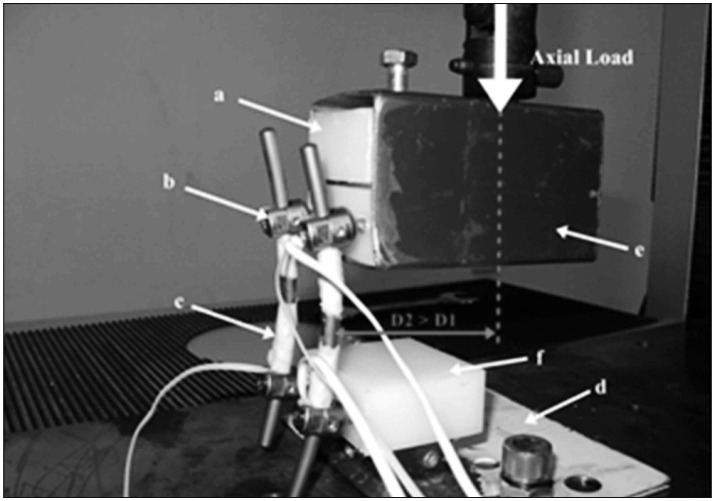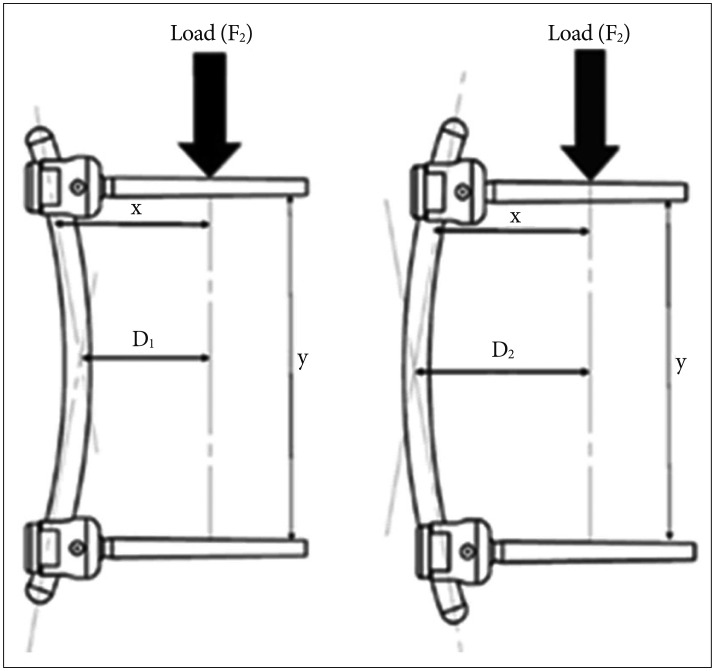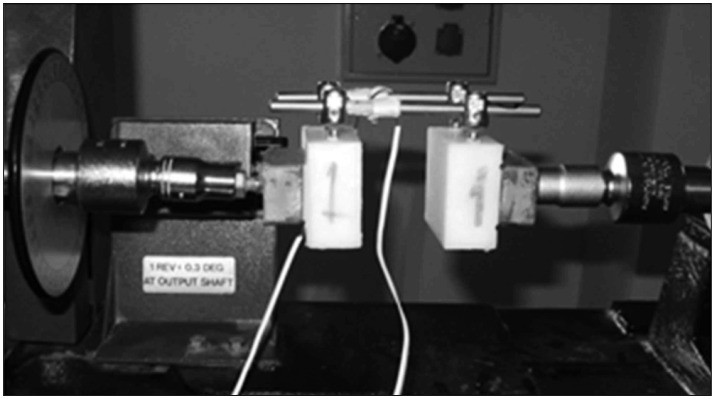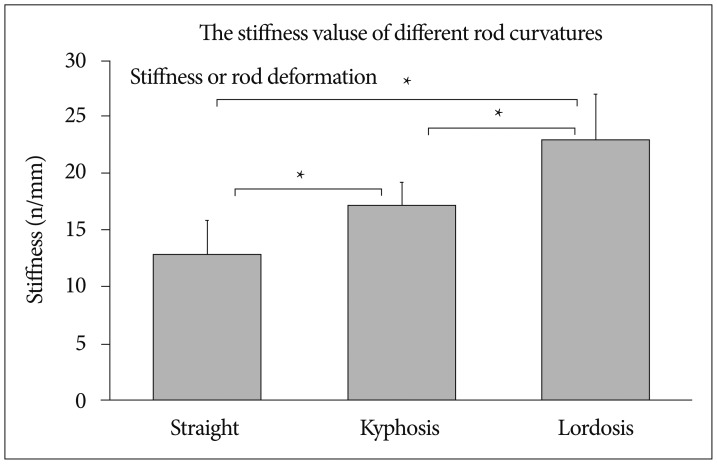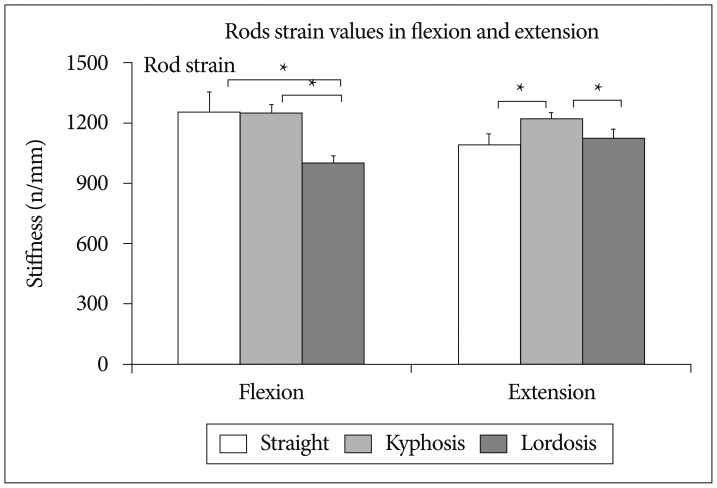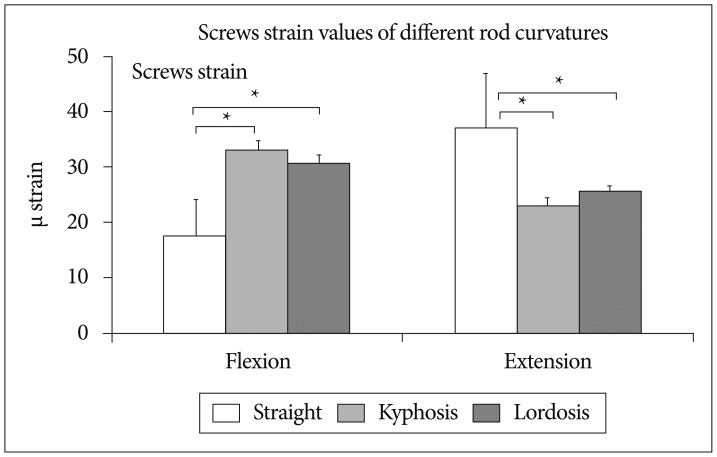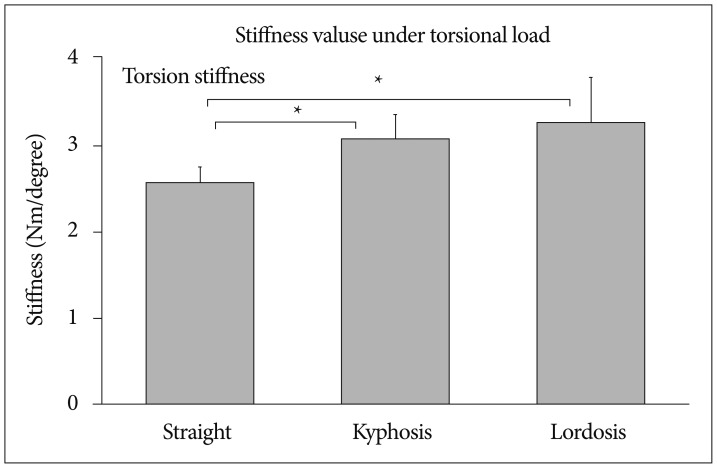J Korean Neurosurg Soc.
2016 Sep;59(5):425-429. 10.3340/jkns.2016.59.5.425.
The Mechanical Effect of Rod Contouring on Rod-Screw System Strength in Spine Fixation
- Affiliations
-
- 1Department of Orthopaedics and Traumatology, Ilyas Cokay Catalca Hospital, Catalca, Istanbul, Turkey. zenanacar@gmail.com
- 2Department of Orthopaedics and Traumatology, Faculty of Medicine, Dokuz Eylul University, Balcova, Izmir, Turkey.
- 3Department of Orthopedics and Traumatology, Sifa Hospital, Konak, Izmir, Turkey.
- 4Department of Computer Engineering, Faculty of Engineering, Dokuz Eylul University, Tinaztepe, Izmir, Turkey.
- 5Department of Biomechanics, Health Science Institute, Dokuz Eylul University, Balcova, Izmir, Turkey.
- KMID: 2351708
- DOI: http://doi.org/10.3340/jkns.2016.59.5.425
Abstract
OBJECTIVE
Rod-screw fixation systems are widely used for spinal instrumentation. Although many biomechanical studies on rod-screw systems have been carried out, but the effects of rod contouring on the construct strength is still not very well defined in the literature. This work examines the mechanical impact of straight, 20° kyphotic, and 20° lordotic rod contouring on rod-screw fixation systems, by forming a corpectomy model.
METHODS
The corpectomy groups were prepared using ultra-high molecular weight polyethylene samples. Non-destructive loads were applied during flexion/extension and torsion testing. Spine-loading conditions were simulated by load subjections of 100 N with a velocity of 5 mm min⻹, to ensure 8.4-Nm moment. For torsional loading, the corpectomy models were subjected to rotational displacement of 0.5° s⻹ to an end point of 5.0°, in a torsion testing machine.
RESULTS
Under both flexion and extension loading conditions the stiffness values for the lordotic rod-screw system were the highest. Under torsional loading conditions, the lordotic rod-screw system exhibited the highest torsional rigidity.
CONCLUSION
We concluded that the lordotic rod-screw system was the most rigid among the systems tested and the risk of rod and screw failure is much higher in the kyphotic rod-screw systems. Further biomechanical studies should be attempted to compare between different rod kyphotic angles to minimize the kyphotic rod failure rate and to offer a more stable and rigid rod-screw construct models for surgical application in the kyphotic vertebrae.
Keyword
Figure
Cited by 1 articles
-
Straight-Forward versus Bicortical Fixation Penetrating Endplate in Lumbosacral Fixation-A Biomechanical Study
Ahmet Karakasli, Nihat Acar, Bora Uzun
J Korean Neurosurg Soc. 2018;61(2):180-185. doi: 10.3340/jkns.2017.0404.004.
Reference
-
1. Alkalay RN, Sharpe D, Bader DL. A biomechanical analysis of an instrumented spinal fixator under torsional loads. J Biomech. 2005; 38:865–876. PMID: 15713308.
Article2. Baaj AA, Reyes PM, Yaqoobi AS, Uribe JS, Vale FL, Theodore N, et al. Biomechanical advantage of the index-level pedicle screw in unstable thoracolumbar junction fractures. J Neurosurg Spine. 2011; 14:192–197. PMID: 21214311.
Article3. Belmont PJ Jr, Polly DW Jr, Cunningham BW, Klemme WR. The effects of hook pattern and kyphotic angulation on mechanical strength and apical rod strain in a long-segment posterior construct using a synthetic model. Spine (Phila Pa 1976). 2001; 26:627–635. PMID: 11305279.
Article4. Chen PQ, Lin SJ, Wu SS, So H. Mechanical performance of the new posterior spinal implant : effect of materials, connecting plate, and pedicle screw design. Spine (Phila Pa 1976). 2003; 28:881–886. PMID: 12942002.
Article5. Chen WJ, Lai PL, Tai CL, Chen LH, Niu CC. The effect of sagittal alignment on adjacent joint mobility after lumbar instrumentation--a biomechanical study of lumbar vertebrae in a porcine model. Clin Biomech (Bristol, Avon). 2004; 19:763–768.
Article6. Gilad R, Gandhi CD, Arginteanu MS, Moore FM, Steinberger A, Camins M. Uncorrected sagittal plane imbalance predisposes to symptomatic instrumentation failure. Spine J. 2008; 8:911–917. PMID: 18082462.
Article7. Karakaşlı A, Sekik E, Karaarslan A, Kızmazoğlu C, Havıtçıoğlu H. Are pedicular screws and lateral hook screws more resistant against pullout than conventional spinal hooks and screws in terminal vertebral segment fixation? Eklem Hastalik Cerrahisi. 2016; 27:22–28. PMID: 26874631.
Article8. Kim H, Lim DH, Oh HJ, Lee KY, Lee SJ. Effects of nonlinearity in the materials used for the semi-rigid pedicle screw systems on biomechanical behaviors of the lumbar spine after surgery. Biomed Mater. 2011; 6:055005. PMID: 21849724.
Article9. Kotani Y, Cunningham BW, Parker LM, Kanayama M, McAfee PC. Static and fatigue biomechanical properties of anterior thoracolumbar instrumentation systems. A synthetic testing model. Spine (Phila Pa 1976). 1999; 24:1406–1413. PMID: 10423784.
Article10. Lehman RA Jr, Polly DW Jr, Kuklo TR, Cunningham B, Kirk KL, Belmont PJ Jr. Straight-forward versus anatomic trajectory technique of thoracic pedicle screw fixation : a biomechanical analysis. Spine (Phila Pa 1976). 2003; 28:2058–2065. PMID: 14501914.
Article11. Liu T, Zheng WJ, Li CQ, Liu GD, Zhou Y. Design and biomechanical study of a modified pedicle screw. Chin J Traumatol. 2010; 13:222–228. PMID: 20670579.12. Mikles MR, Asghar FA, Frankenburg EP, Scott DS, Graziano GP. Biomechanical study of lumbar pedicle screws in a corpectomy model assessing significance of screw height. J Spinal Disord Tech. 2004; 17:272–276. PMID: 15280754.
Article13. Okamoto T, Neo M, Fujibayashi S, Ito H, Takemoto M, Nakamura T. Mechanical implant failure in posterior cervical spine fusion. Eur Spine J. 2012; 21:328–334. PMID: 22002474.
Article14. Ponnappan RK, Serhan H, Zarda B, Patel R, Albert T, Vaccaro AR. Biomechanical evaluation and comparison of polyetheretherketone rod system to traditional titanium rod fixation. Spine J. 2009; 9:263–267. PMID: 18838341.
Article15. Schroerlucke SR, Akbarnia BA, Pawelek JB, Salari P, Mundis GM Jr, Yazici M, et al. How does thoracic kyphosis affect patient outcomes in growing rod surgery? Spine (Phila Pa 1976). 2012; 37:1303–1309. PMID: 22210014.
Article16. Smith JS, Shaffrey CI, Ames CP, Demakakos J, Fu KM, Keshavarzi S, et al. Assessment of symptomatic rod fracture after posterior instrumented fusion for adult spinal deformity. Neurosurgery. 2012; 71:862–867. PMID: 22989960.
Article17. Stanford RE, Loefler AH, Stanford PM, Walsh WR. Multiaxial pedicle screw designs : static and dynamic mechanical testing. Spine (Phila Pa 1976). 2004; 29:367–375. PMID: 15094532.18. Sun E, Alkalay R, Vader D, Snyder BD. Preventing distal pullout of posterior spine instrumentation in thoracic hyperkyphosis : a biomechanical analysis. J Spinal Disord Tech. 2009; 22:270–277. PMID: 19494747.
Article19. Villa T, La Barbera L, Galbusera F. Comparative analysis of international standards for the fatigue testing of posterior spinal fixation systems. Spine J. 2014; 14:695–704. PMID: 24268390.
Article20. Wahba GM, Bhatia N, Bui CN, Lee KH, Lee TQ. Biomechanical evaluation of short-segment posterior instrumentation with and without crosslinks in a human cadaveric unstable thoracolumbar burst fracture model. Spine (Phila Pa 1976). 2010; 35:278–285. PMID: 20075769.
Article21. Wang XY, Dai LY, Xu HZ, Chi YL. Biomechanical effect of the extent of vertebral body fracture on the thoracolumbar spine with pedicle screw fixation : an in vitro study. J Clin Neurosci. 2008; 15:286–290. PMID: 18226530.
Article22. Xu HZ, Wang XY, Chi YL, Zhu QA, Lin Y, Huang QS, et al. Biomechanical evaluation of a dynamic pedicle screw fixation device. Clin Biomech (Bristol, Avon). 2006; 21:330–336.
Article
- Full Text Links
- Actions
-
Cited
- CITED
-
- Close
- Share
- Similar articles
-
- Changes of Fixation Strength by Rod - Contouring of Compact Cotrel - Dubousset Instrumentation
- Technical aspects of rod-insertion forceps (persuader) application in reducing construct failure after lumbar spine fusion surgery: a biomechanical cadaveric study in Germany
- Comparative Analysis of Effect of Density, Insertion Angle and Reinsertion on Pull-Out Strength of Single and Two Pedicle Screw Constructs Using Synthetic Bone Model
- Biomechanical Efficacy of Various Anterior Spinal Fixation in Treatment of Thoraco-lumbar Spine Fracture
- The Result of the Posterolateral Fusion with Knodt Rod and without Knodt Rod in Spondylolysis and Spondylolisthesis of the Lumbar Spine

